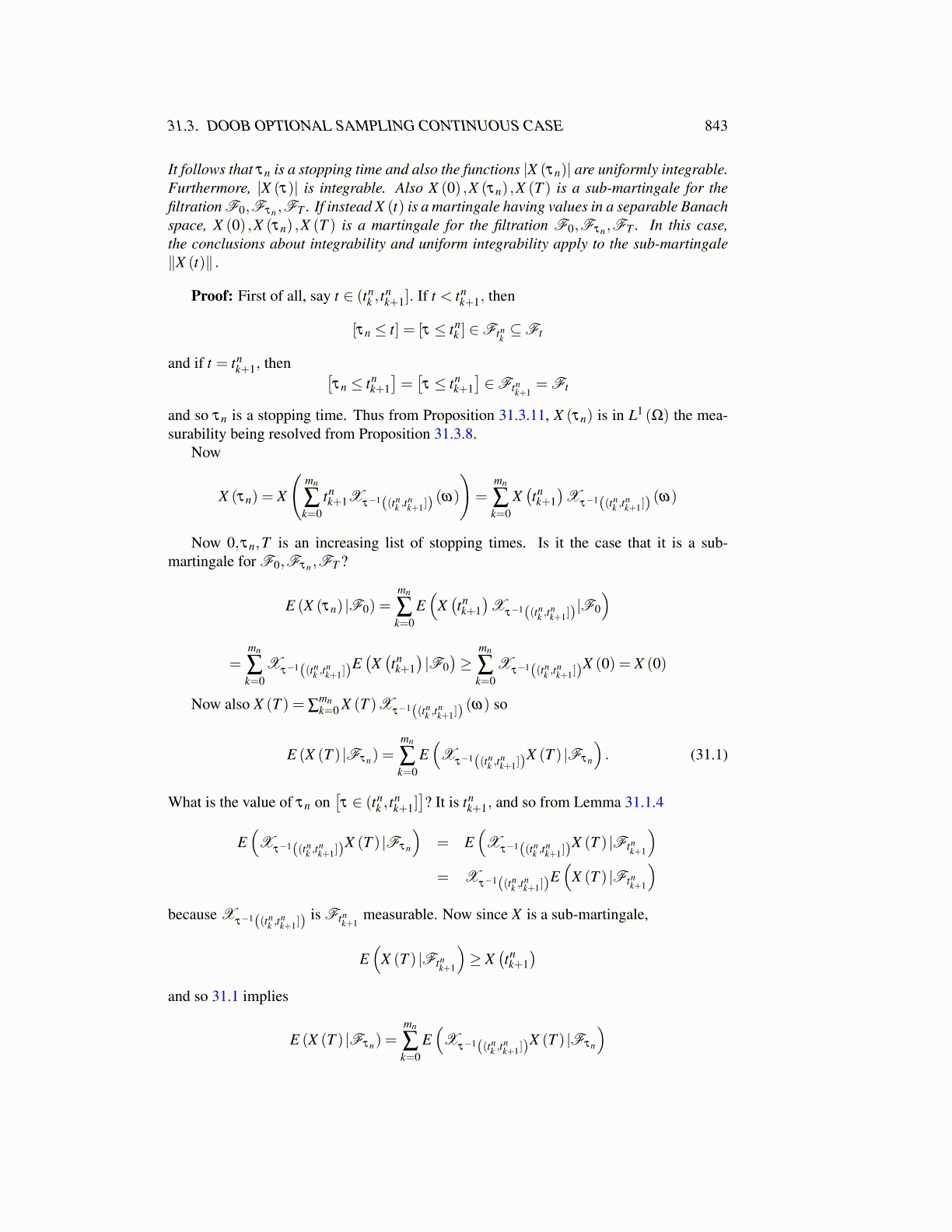
31.3. DOOB OPTIONAL SAMPLING CONTINUOUS CASE 843
It follows that τn is a stopping time and also the functions |X (τn)| are uniformly integrable.Furthermore, |X (τ)| is integrable. Also X (0) ,X (τn) ,X (T ) is a sub-martingale for thefiltration F0,Fτn ,FT . If instead X (t) is a martingale having values in a separable Banachspace, X (0) ,X (τn) ,X (T ) is a martingale for the filtration F0,Fτn ,FT . In this case,the conclusions about integrability and uniform integrability apply to the sub-martingale∥X (t)∥ .
Proof: First of all, say t ∈ (tnk , t
nk+1]. If t < tn
k+1, then
[τn ≤ t] = [τ ≤ tnk ] ∈Ftn
k⊆Ft
and if t = tnk+1, then [
τn ≤ tnk+1]=[τ ≤ tn
k+1]∈Ftn
k+1= Ft
and so τn is a stopping time. Thus from Proposition 31.3.11, X (τn) is in L1 (Ω) the mea-surability being resolved from Proposition 31.3.8.
Now
X (τn) = X
(mn
∑k=0
tnk+1Xτ−1((tn
k ,tnk+1])
(ω)
)=
mn
∑k=0
X(tnk+1)X
τ−1((tnk ,t
nk+1])
(ω)
Now 0,τn,T is an increasing list of stopping times. Is it the case that it is a sub-martingale for F0,Fτn ,FT ?
E (X (τn) |F0) =mn
∑k=0
E(
X(tnk+1)X
τ−1((tnk ,t
nk+1])|F0
)
=mn
∑k=0
Xτ−1((tn
k ,tnk+1])
E(X(tnk+1)|F0
)≥
mn
∑k=0
Xτ−1((tn
k ,tnk+1])
X (0) = X (0)
Now also X (T ) = ∑mnk=0 X (T )X
τ−1((tnk ,t
nk+1])
(ω) so
E (X (T ) |Fτn) =mn
∑k=0
E(X
τ−1((tnk ,t
nk+1])
X (T ) |Fτn
). (31.1)
What is the value of τn on[τ ∈ (tn
k , tnk+1]
]? It is tn
k+1, and so from Lemma 31.1.4
E(X
τ−1((tnk ,t
nk+1])
X (T ) |Fτn
)= E
(X
τ−1((tnk ,t
nk+1])
X (T ) |Ftnk+1
)= X
τ−1((tnk ,t
nk+1])
E(
X (T ) |Ftnk+1
)because X
τ−1((tnk ,t
nk+1])
is Ftnk+1
measurable. Now since X is a sub-martingale,
E(
X (T ) |Ftnk+1
)≥ X
(tnk+1)
and so 31.1 implies
E (X (T ) |Fτn) =mn
∑k=0
E(X
τ−1((tnk ,t
nk+1])
X (T ) |Fτn
)